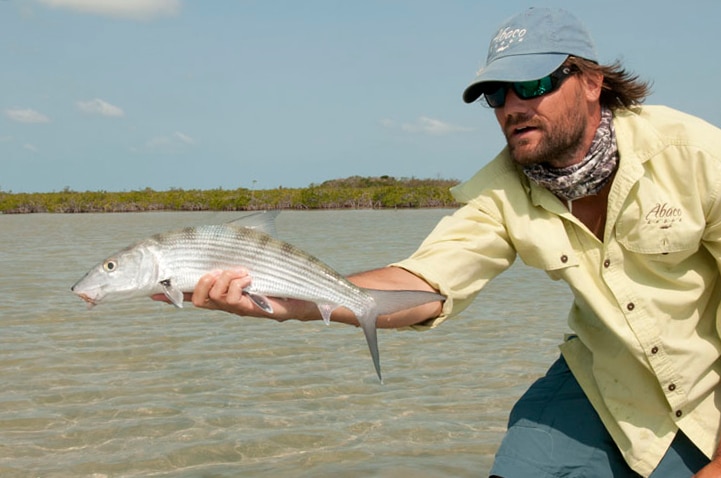
Catch Bonefish
Incredible tenacity and an inherently “spooky” nature make this flats fish the most commonly sought-after saltwater game fish on fly. This ghost of the flats has the uncanny ability to appear and disappear almost at will and tends to flee at the slightest disturbance. Stalking bones on the flats becomes every bit as much a hunt as it is fishing. As with any hunt, it’s best to know as much as you can about the prey, including its habitat and habits.
Habitat and Behavior
When you’re fishing in water only a foot deep, tide and time of day can have a dramatic effect on water temperature, and these factors can change a barren flat to a productive one almost instantly.
According to fisheries biologist Derke Snodgrass, like many flats fish, bones prefer water ranging in temperature from the mid-70s to the mid-80s. “If the water gets too much warmer, they stay in deeper channels,” says Snodgrass. An incoming tide can suddenly warm cooler water or cool warmer water. Subsequently, during cooler weather the middle of a sunny day presents a good time to look for bones on the flats, while early morning and late evening provide better fishing in the heat of summer.
Tides are critical to bonefish in another way, too. According to Snodgrass, it appears that bones spend more time on large, expansive flats during the rising tides. On deeper flats, or flats adjacent to deep water, however, bonefish may be present regardless of tidal flow. The best time to fish large shallow flats is during the higher stages of the tide when the fish can safely swim onto the flat and feed throughout the slack tidal period. If the tide is low or falling, look for drop-offs over which the warm water will recede because bonefish will be following the warm water. Keep in mind that large flats that remain too shallow for bones to feed for most of the month will almost always draw bonefish when extra-strong tides associated with the full and new moon flood the area.

Studies indicate that regardless of the habitat, bones feed mostly on mollusks and crustaceans like pistol and mantis shrimp, shrimp eels, toadfish and small crabs found in the sand or on the bottom. Studies by the Florida Marine Research Institute suggest large bonefish, 17 inches and up, eat more shrimp, toadfish and crabs than smaller bones. The major difference in these prey items within different environments is coloration. As you might expect, on grassy flats like those in the Keys, the prey items are darker, while over hard or sandy-bottomed flats the prey items tend to be lighter in color.
The bonefish’s protruding upper jaw and long, rounded snout allow the bonefish to root along the bottom for food. On soft, sandy-bottomed flats, “blast holes” or small circular patterns left in the sand by feeding bonefish can be a sure sign that bonefish are present. Mud clouds are also definite indicators of feeding on the flats. A little experience will help in distinguishing a bonefish “mud” from other species’ muds, but according to well-known bonefish angler Mitch Howell, size and density usually make it obvious – bonefish tend to create light, small, quick muds compared to rays or even permit.
Unfortunately, Snodgrass says that there are no real patterns that explain bonefish feeding or migrations.
“Daily activities vary from day to day, even under the same tidal circumstances, and tagging studies suggest it is unlikely that the same fish frequent the same flats for long periods of time,” he says. “Studies indicate these fish travel often and possibly quite far.”
Many guides feel that bonefish frequently feed into the general direction of the current, albeit erratically. Bonefish will feed in all types of current conditions, but they are easiest to pursue with at least a moderate current. Near channels with fast currents the fish feed quickly, and in situations with no current, like slack tides, bones do not readily feed, and movements are harder to predict.
Geographic Variation
Differences between bonefish at different locations range from subtle to distinct and form the basis for ongoing debates regarding the exact number of species that exist. Most important for the angler are the behavioral differences. For example, compared to Bahamian bones, the bones in the Keys are fewer, but larger, according to Snodgrass. He suggests this may be due to the nature of the environment itself. “The Bahamas have lots of habitat and lots of fish, so the fish remain smaller but feed more aggressively,” he says.
In general, bonefish in the Florida Keys and Bahamas average between 4 and 6 pounds with frequent large fish exceeding 10 pounds. Fish in the Yucatan and other parts of the Caribbean normally do not exceed 2 to 3 pounds on average, though of course larger fish exist there. Bones found on Pacific flats are similar to Caribbean fish in size. Reports of fish over 10 pounds have come from the Seychelle Islands in the Indian Ocean, and 20-pounders have been taken in the deep waters around Hawaii and Africa. Howell, who specializes in large bones, believes that deeper flats (5 to 6 feet) generally hold bigger fish. However, most anglers, including Howell, seem to agree that the best place to fish for big bones remains the Florida Keys, even though these fish are targeted heavily and are quite wary as a result. To fish these large bones, Howell recommends windy, cloudy days that allow the angler a little more room for error.









